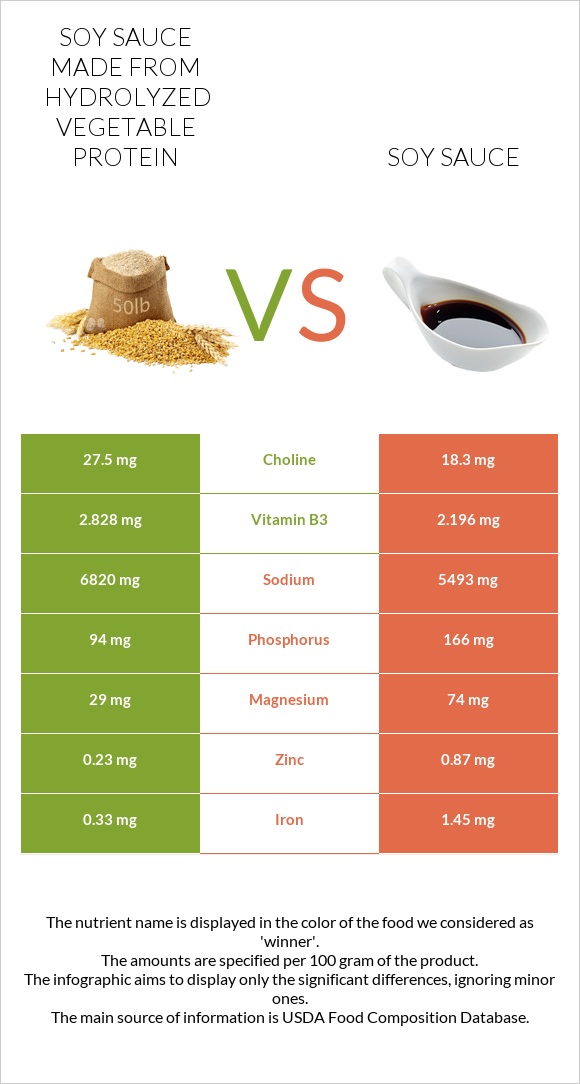Soy sauce made from hydrolyzed vegetable protein vs. Soy sauce — In-Depth Nutrition Comparison
Compare
How are soy sauce made from hydrolyzed vegetable protein and soy sauce different?
- Soy sauce is higher than soy sauce made from hydrolyzed vegetable protein in manganese, iron, magnesium, phosphorus, and zinc.
- Soy sauce made from hydrolyzed vegetable protein covers your daily need for sodium, 58% more than soy sauce.
- Soy sauce made from hydrolyzed vegetable protein contains 2 times more choline than soy sauce. Soy sauce made from hydrolyzed vegetable protein contains 27.5mg of choline, while soy sauce contains 18.3mg.
- Soy sauce is lower in sodium.
Soy sauce made from hydrolyzed vegetable protein and Soy sauce made from soy and wheat (shoyu) types were used in this article.
Infographic

Infographic link
Mineral Comparison
Mineral comparison score is based on the number of minerals by which one or the other food is richer. The "coverage" charts below show how much of the daily needs can be covered by 300 grams of the food.
| Contains more SeleniumSelenium | +60% |
| Contains more MagnesiumMagnesium | +155.2% |
| Contains more CalciumCalcium | +94.1% |
| Contains more IronIron | +339.4% |
| Contains more ZincZinc | +278.3% |
| Contains more PhosphorusPhosphorus | +76.6% |
| Contains less SodiumSodium | -19.5% |
| Contains more ManganeseManganese | +918% |
Vitamin Comparison
Vitamin comparison score is based on the number of vitamins by which one or the other food is richer. The "coverage" charts below show how much of the daily needs can be covered by 300 grams of the food.
| Contains more Vitamin B1Vitamin B1 | +27.3% |
| Contains more Vitamin B3Vitamin B3 | +28.8% |
| Contains more Vitamin B2Vitamin B2 | +51.4% |
| Contains more Vitamin B5Vitamin B5 | +10.4% |
All nutrients comparison - raw data values
| Nutrient |  |
 |
DV% diff. |
| Sodium | 6820mg | 5493mg | 58% |
| Manganese | 0.1mg | 1.018mg | 40% |
| Iron | 0.33mg | 1.45mg | 14% |
| Magnesium | 29mg | 74mg | 11% |
| Phosphorus | 94mg | 166mg | 10% |
| Zinc | 0.23mg | 0.87mg | 6% |
| Vitamin B2 | 0.109mg | 0.165mg | 4% |
| Vitamin B3 | 2.828mg | 2.196mg | 4% |
| Protein | 7g | 8.14g | 2% |
| Calcium | 17mg | 33mg | 2% |
| Choline | 27.5mg | 18.3mg | 2% |
| Carbs | 7.84g | 4.93g | 1% |
| Fiber | 0.5g | 0.8g | 1% |
| Selenium | 0.8µg | 0.5µg | 1% |
| Vitamin B1 | 0.042mg | 0.033mg | 1% |
| Vitamin B5 | 0.269mg | 0.297mg | 1% |
| Polyunsaturated fat | 0.147g | 0.263g | 1% |
| Calories | 60kcal | 53kcal | 0% |
| Fats | 0.51g | 0.57g | 0% |
| Net carbs | 7.34g | 4.13g | N/A |
| Potassium | 447mg | 435mg | 0% |
| Sugar | 1.3g | 0.4g | N/A |
| Copper | 0.041mg | 0.043mg | 0% |
| Vitamin B6 | 0.143mg | 0.148mg | 0% |
| Folate | 13µg | 14µg | 0% |
| Saturated fat | 0.04g | 0.073g | 0% |
| Monounsaturated fat | 0.06g | 0.088g | 0% |
| Tryptophan | 0.096mg | 0% | |
| Threonine | 0.271mg | 0% | |
| Isoleucine | 0.318mg | 0% | |
| Leucine | 0.537mg | 0% | |
| Lysine | 0.381mg | 0% | |
| Methionine | 0.097mg | 0% | |
| Phenylalanine | 0.353mg | 0% | |
| Valine | 0.332mg | 0% | |
| Histidine | 0.174mg | 0% |
Macronutrient Comparison
Macronutrient breakdown side-by-side comparison
Protein:
7 g
Fats:
0.51 g
Carbs:
7.84 g
Water:
68.02 g
Other:
16.63 g
Protein:
8.14 g
Fats:
0.57 g
Carbs:
4.93 g
Water:
71.15 g
Other:
15.21 g
| Contains more CarbsCarbs | +59% |
| Contains more ProteinProtein | +16.3% |
| Contains more FatsFats | +11.8% |
~equal in
Water
~71.15g
~equal in
Other
~15.21g
Fat Type Comparison
Fat type breakdown side-by-side comparison
Saturated fat:
Sat. Fat
0.04 g
Monounsaturated fat:
Mono. Fat
0.06 g
Polyunsaturated fat:
Poly. Fat
0.147 g
Saturated fat:
Sat. Fat
0.073 g
Monounsaturated fat:
Mono. Fat
0.088 g
Polyunsaturated fat:
Poly. Fat
0.263 g
| Contains less Sat. FatSaturated fat | -45.2% |
| Contains more Mono. FatMonounsaturated fat | +46.7% |
| Contains more Poly. FatPolyunsaturated fat | +78.9% |
Carbohydrate type comparison
Carbohydrate type breakdown side-by-side comparison
Starch:
0 g
Sucrose:
0 g
Glucose:
0.7 g
Fructose:
0 g
Lactose:
0 g
Maltose:
0.6 g
Galactose:
0 g
Starch:
0 g
Sucrose:
0.1 g
Glucose:
0.3 g
Fructose:
0 g
Lactose:
0 g
Maltose:
0 g
Galactose:
0 g
| Contains more GlucoseGlucose | +133.3% |
| Contains more MaltoseMaltose | +∞% |
| Contains more SucroseSucrose | +∞% |
~equal in
Starch
~0g
~equal in
Fructose
~0g
~equal in
Lactose
~0g
~equal in
Galactose
~0g